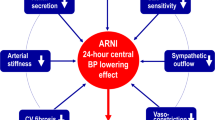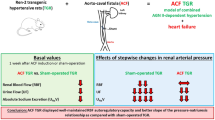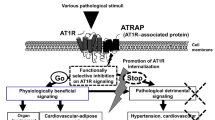Abstract
The sensitivity of blood vessels to the vasoconstrictor effects of the hormone angiotensin II appears to be modulated by the activity of the renin–angiotensin system. Elevation of circulating angiotensin II levels by sodium depletion or renal artery stenosis is associated with a diminished pressor response to infused angiotensin II (refs 1–3). Conversely, the vasoconstrictor response to the hormone is enhanced when endogenous angiotensin II levels are reduced by sodium loading1,4 or nephrectomy5. The mechanisms of these varying effects are not known, but physiological and pharmacological experiments suggest involvement of the vascular smooth muscle receptor for angiotensin II (refs 5–8). Modification of the interaction between angiotensin II and its vascular receptor, resulting in altered responsiveness to the hormone, could occur either via ‘prior occupancy’ of receptors by elevated levels of endogenous angiotensin II resulting in fewer free receptors available to respond to circulating angiotensin II (ref. 5), or, elevated levels of angiotensin II could result in a decrease in receptor affinity for the hormone7 or a decrease in total receptor number in the vascular smooth muscle cell8. We now report the first direct evidence, by radioligand binding assay, that angiotensin II regulates the number of its own receptors in resistance vasculature.
This is a preview of subscription content, access via your institution
Access options
Subscribe to this journal
Receive 51 print issues and online access
$199.00 per year
only $3.90 per issue
Buy this article
- Purchase on Springer Link
- Instant access to full article PDF
Prices may be subject to local taxes which are calculated during checkout
Similar content being viewed by others
References
Reid, W. D. & Laragh, J. H. Proc. Soc. exp. Biol. Med. 120, 26–29 (1965).
Hollenberg, N. K., Solomon, H. S., Adams, D. F., Abrams, H. L. & Merrill, J. P. Circulation Res. 31, 750–757 (1972).
Kaplan, N. M. & Silah, J. G. J. clin. Invest. 43, 659–669 (1964).
Healy, J. K., Suszkiw, J. B. & Schreiner, G. E. Nephron 3, 329–343 (1969).
Swales, J. D., Tange, J. D. & Thurston, H. Circulation Res. 37, 96–100 (1975).
Thurston, H. Am. J. Med. 61, 768–778 (1976).
Brunner, H. R., Chang, P., Wallach, R., Sealey, J. E. & Laragh, J. H. J. clin. Invest. 51, 58–67 (1972).
Devynck, M. A. & Meyer, P. Am. J. Med. 61, 758–767 (1976).
Gunther, S., Gimbrone, M. A. Jr & Alexander, R. W. Circulation Res. 47, 278–286 (1980).
Powell-Jackson, J. D. & MacGregor, J. J. Endocrinology 68, 175–176 (1976).
Rubin, B. M., Antonaccio, M. J. & Horovitz, Z. P. Prog. cardiovasc. Dis. 21, 183–194 (1978).
Emanuel, R. L., Cain, J. P. & Williams, G. H. J. Lab. clin. Med. 81, 632–640 (1973).
Erdös, E. G. & Yang, H. Y. T. in Handbook of Experimental Pharmacology (ed. Erdös, E. G.) 289–323 (Springer, New York, 1970).
Morgat, J. L., Hung, L. T. & Fromageot, P. Biochim. biophys. Acta 207, 374–376 (1970).
Regoli, D., Park, W. K. & Rioux, F. Pharmac. Rev. 26, 69–123 (1974).
Kahn, C. R., Meville, D. M. & Roth, J. J. biol. Chem. 248, 244–250 (1973).
Srikant, C. B., Freeman, D., McCorkle, K. & Unger, R. H. J. biol. Chem. 252, 7434–7436 (1977).
Lesniak, M. A. & Roth, J. J. biol. Chem. 251, 3720–3729 (1976).
Catt, K. J., Harwood, J. P., Aguilera, G. & Dufau, M. L. Nature 280, 109–116 (1979).
Hollenberg, N. K., Chenitz, W. R., Adams, D. F. & Williams, G. H. J. clin. Invest. 54, 34–42 (1974).
Aguilera, G., Hauger, R. L. & Catt, K. J. Proc. natn. Acad. Sci. U.S.A. 75, 975–979 (1978).
Devynck, M. A. et al. Clin. Sci. molec. Med. 55, 171s–174s (1978).
Meyer, P., Papadimitriou, S. & Worcel, M. Br. J. Pharmac. 51, 435–439 (1974).
Devynck, M. A., Rouzaire-Dubois, B., Chevillotte, E. & Meyer, P. Eur. J. Pharmac. 40, 27–37 (1976).
Thurston, H. & Laragh, J. H. Circulation Res. 36, 113–117 (1975).
Oliver, J. A. & Cannon, P. J. J. clin. Invest. 61, 610–623 (1978).
Author information
Authors and Affiliations
Rights and permissions
About this article
Cite this article
Gunther, S., Gimbrone, M. & Alexander, R. Regulation by angiotensin II of its receptors in resistance blood vessels. Nature 287, 230–232 (1980). https://doi.org/10.1038/287230a0
Received:
Accepted:
Issue Date:
DOI: https://doi.org/10.1038/287230a0
This article is cited by
-
The angiotensin II AT1 receptor-associated protein Arap1 is involved in sepsis-induced hypotension
Critical Care (2013)
-
Angiotensin receptor-associated proteins: local modulators of the renin–angiotensin system
Pflügers Archiv - European Journal of Physiology (2013)
-
Central role of the AT1-receptor in atherosclerosis
Journal of Human Hypertension (2002)
-
Modulation and function of extrarenal angiotensin receptors
Cell Biochemistry and Biophysics (1999)
-
Down‐regulation of aortic and cardiac AT1 receptor gene expression in transgenic (mRen‐2) 27 rats
British Journal of Pharmacology (1997)
Comments
By submitting a comment you agree to abide by our Terms and Community Guidelines. If you find something abusive or that does not comply with our terms or guidelines please flag it as inappropriate.



